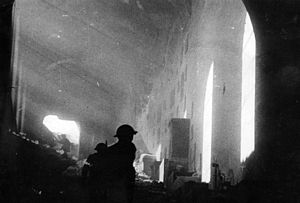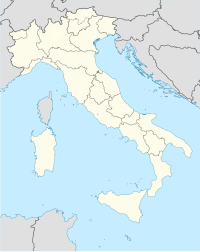
Back معركة مونتي كاسينو Arabic مونته کاسینو دؤیوشو AZB Бітва пад Монтэ-Касіна (1944) BE Бітва пад Монтэ-Касына BE-X-OLD Битка при Монте Касино Bulgarian Emgann Monte Cassino BR Bitka za Monte Cassino BS Batalla de Montecassino Catalan Bitva o Monte Cassino Czech Slaget om Monte Cassino Danish
This article's tone or style may not reflect the encyclopedic tone used on Wikipedia. (December 2019) |
| Battle of Monte Cassino | |||||||
|---|---|---|---|---|---|---|---|
| Part of the Italian campaign of World War II | |||||||
 Polish soldiers inside the ruined Monte Cassino monastery | |||||||
| |||||||
| Belligerents | |||||||
|
• • |
| ||||||
| Commanders and leaders | |||||||
|
|
| ||||||
| Units involved | |||||||
|
|
| ||||||
| Strength | |||||||
|
240,000 men 1,900 tanks 4,000 planes[2] | 140,000 men | ||||||
| Casualties and losses | |||||||
| 55,000 casualties[3] | ~20,000 casualties[3] | ||||||
| 2,000 civilian deaths[4] | |||||||
Monte Cassino, Italy | |||||||
The Battle of Monte Cassino, also known as the Battle for Rome, was a series of four military assaults by the Allies against German forces in Italy during the Italian Campaign of World War II. The objective was to break through the Winter Line and facilitate an advance towards Rome.
In the beginning of 1944, the western half of the Winter Line was anchored by German forces holding the Rapido-Gari, Liri, and Garigliano valleys and several surrounding peaks and ridges. Together, these features formed the Gustav Line. Monte Cassino, a historic hilltop abbey founded in 529 by Benedict of Nursia, dominated the nearby town of Cassino and the entrances to the Liri and Rapido valleys. Lying in a protected historic zone, it had been left unoccupied by the Germans, although they manned some positions set into the slopes below the abbey's walls.
Repeated artillery attacks on assaulting allied troops caused their leaders to incorrectly conclude that the abbey was being used by the Germans as an observation post, at the very least. Fears escalated, along with casualties, and despite evidence, it was marked for destruction. On 15 February 1944, Allied bombers dropped 1,400 tonnes of high explosives, causing widespread damage.[5] Fallschirmjäger forces occupied the area and established defensive positions amid the ruins.
Between 17 January and 18 May, Monte Cassino and the Gustav Line defences were attacked on four occasions by Allied troops. On 16 May, soldiers from the Polish II Corps launched one of the final assaults on the German defensive position as part of a twenty-division assault along a thirty-two kilometres front. On 18 May, a Polish flag and the British flag were raised over the ruins.[6] Following this Allied victory, the German Senger Line collapsed on 25 May, and the German defenders were driven from their positions.[7] The capture of Monte Cassino resulted in 55,000 Allied casualties, with German losses estimated at around 20,000 killed and wounded.[3] The battle has been described as a Pyrrhic victory.[8][9]
- ^ Earle, Neil. "Remembering the battle for Monte Cassino, and the role played by Newfoundlanders". SaltWire. Retrieved 14 August 2022.
- ^ Farrington, K, (1995), Battle for Victory. Bookmart Ltd, p. 45
- ^ a b c Axelrod, Alan (2008). Real History of World War II: A New Look at the Past. New York: Sterling Publishing Co Inc. p. 208. ISBN 978-1-4027-4090-9.
- ^ Cassino dalla distruzione alla rinascita
- ^ Manchester, William; Paul Reid (2012). The Last Lion, Winston Spencer Churchill: Defender of the Realm 1940–1965 (1st ed.). Boston: Little, Brown. p. 801. ISBN 978-0316547703.
- ^ "Monte Cassino—a battle for Poland". #Poland. Archived from the original on 7 January 2019. Retrieved 6 January 2019.
- ^ Jordan, D, (2004), Atlas of World War II. Barnes & Noble Books, p. 92.
- ^ Parker 2004, p. 347
- ^ Crwys-Williams, Jennifer (1992). A country at war, 1939–1945: the mood of a nation. Ashanti Publications. p. 358. ISBN 978-1-874800-49-1.
